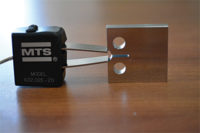Founded in 1967, the building blocks for WMT&R were stress rupture and creep testing for aerospace and defense industries. Today, WMT&R runs commercial testing labs, with services that include advanced research and materials testing for many different industries, including power generation, aerospace, nuclear, automotive and defense. The company has put a wide range of materials to the test over the years, including aluminum and titanium (used in aerospace and defense), nickel, iron, cobalt, steel alloys, metal matrix composites, intermetallics, plastics, powdered metals, super alloys and various steels. The company has even conducted mechanical testing on gold and silver for dental and electronic applications and tensile tests on platinum.
Throughout WMT&R's history, all of their tests have had one common criterion: Customers want results yesterday. Customer demands for fast results have increased even more in recent years, with global competition raising the stakes and customers looking for every possible competitive advantage. Tests that once took three to five days to report results now need to be completed in one or two days.
Fast turnaround without compromising accurate results has helped the company grow to the point where they now utilize more than 100,000 square feet of testing space and have more than 130 employees. And WMT&R relies on a partnership with Instron to help continue to grow as a company.
When WMT&R was about seven years old, they turned to Instron to obtain a new FastTrack 8500 fatigue testing system.
According to Charles Boyle, WMT&R's quality assurance inspection supervisor, this was the beginning of a mutually rewarding alliance. "We found Instron's servohydraulic fatigue testing equipment to be reliable, accurate and robust," he says. "Downtime is never a big issue. The Instron systems are easy to work on and work with. For example, Instron machines are easy to change from low- to high-cycle fatigue with simple changes of extensometers, grips and fixtures."
The Instron FastTrack 8500 and 8800 series of servohydraulic fatigue test systems form the heart of WMT&R's fracture and fatigue testing area. Designed to simulate "in-service" conditions in a lab environment, the systems can apply loads to a specimen in the range of one to more than 1 million pounds. The fatigue testers also give the company the ability to cycle specimens from low rates up to frequencies as high as 200 Hz. Tests are conducted in various atmospheres including argon, vacuum, open-air and temperature conditions that range from -425 F to +2200 F. The systems agility, high speed and digital electronics deliver the control and accuracy that WMT&R requires, and also help to produce the efficiency that customers have come to expect.
"We needed to test and machine 1,000 pieces in seven days. To accomplish this seemingly insurmountable feat and meet this tight deadline, we put 34 to 41 fatigue testing systems to work around the clock. The job was actually completed ahead of schedule, with never a need for corrective maintenance or downtime. Instron's workhorses got the job done," Boyle says.
The most recent addition to the company's fleet of Instron systems is the 8150 Drop Weight Impact Test System. This high-energy impact test machine provides WMT&R with the ability to measure impact energies up to 20,000 ft.-lbs., and impact velocities up to 22 ft./s. The company uses the impact test system for dynamic tear testing, determining energy absorption, identifying fracture resistance and other applications. Because the 8150 provides high-capacity testing, the design of the system is quite tall. WMT&R had to cut a hole in the roof of its Impact laboratory to accommodate an aerial installation of the system.
"When customers come to WMT&R, they know they can count on three principal competitive advantages," Boyle says. "They receive the benefit of our high testing capacity, with a lab dedicated to fast turnaround. They work with experienced, knowledgeable professionals. And they obtain the kind of results that only can be derived from utilization of the top technology. For decades we've counted on the Instron systems to deliver those results."
Instron Corp.
(800) 564-8378
Benefits
The fatigue test systems easily change from low- to high-cycle fatigue with simple changes of extensometers, grips and fixtures.
The fatigue test systems can apply loads to a specimen from one to more than 1 million pounds.
The company can cycle specimens from low rates to frequencies as high as 200 Hz.
